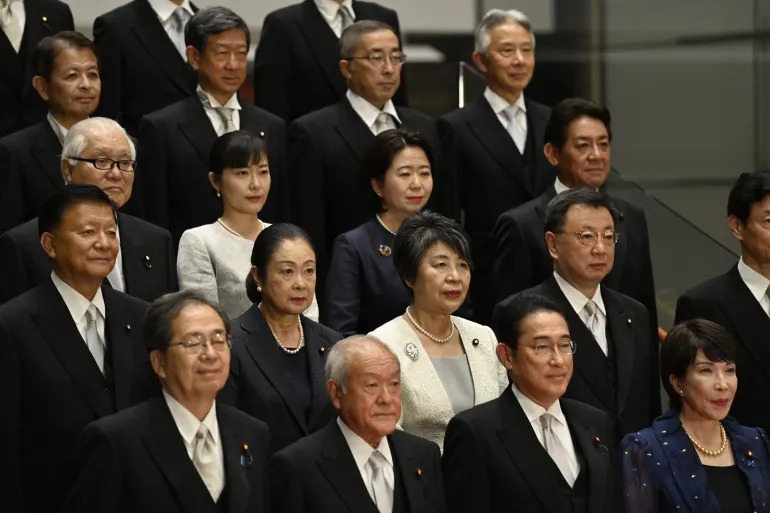In a bold move aimed at reversing his plummeting approval ratings, Japanese Prime Minister Fumio Kishida has undertaken a significant cabinet reshuffle, appointing five women to key ministerial positions – the highest number since 2014. The decision to bolster female representation within the government comes amidst mounting concerns over sluggish wage growth, the rising cost of living, and political turmoil. Kishida hopes that this strategic maneuver will resonate with progressive and younger voters, who have increasingly abandoned his party.
A Historic Appointment at the Helm of Foreign Affairs
Kishida’s cabinet reshuffle has created history with the appointment of Yoko Kamikawa as Japan’s first female Minister of Foreign Affairs in nearly two decades. Kamikawa, who previously served as Japan’s justice minister, gained notoriety for overseeing the execution of key figures in the Aum Shinrikyo doomsday cult, responsible for the deadly sarin gas attack on the Tokyo metro system in 1995. In her first press conference, Kamikawa emphasized Japan’s commitment to building trust with global partners and seeking responsible actions from China to mend strained ties.
Addressing Gender Inequality in Politics
Before this reshuffle, only two out of 19 cabinet members were women, highlighting the significant gender disparity in Japanese politics. Japan currently ranks 138th out of 146 nations in terms of gender equality in politics, according to the World Economic Forum. The addition of Hanako Jimi as the Minister for Regional Revitalization, Ayuko Kato as the custodian of child policies, and Shinako Tsuchiya as the reconstruction minister marks a step towards gender inclusivity. Additionally, Yuko Obuchi, who chairs the ruling Liberal Democratic Party’s election strategy committee, is the daughter of the late Prime Minister Keizo Obuchi, and Kishida aims to harness her talents to fulfill the party’s goal of having women occupy 30 percent of parliamentary seats within a decade.
A Question of Style vs. Substance
While the appointment of five women to prominent government positions is undoubtedly significant, experts warn that it may not resolve the broader issue of gender inequality within the Liberal Democratic Party (LDP). Unlike rival parties such as the Japan Communist Party, the LDP does not set quotas for female candidates, which results in preferential treatment for incumbent male candidates. This gender imbalance, critics argue, necessitates institutional changes to foster genuine progress.
Challenges Beyond Gender
Yet, the challenge for Prime Minister Kishida extends beyond addressing gender disparities. His approval ratings have been on a steady decline since July 2022, reaching an alarming low of 33.1 percent in December. The root causes of this decline lie in pressing economic issues, including inflation and the rising cost of living. Kishida’s popularity did experience a slight uptick following the G7 summit held in Hiroshima, his hometown, but quickly receded.
Handling the My Number Identification System Crisis
Kishida’s mismanagement of Japan’s My Number Identification system, introduced in 2015 to create a unified national identifying number, has contributed to his dwindling support. The system has grappled with technical glitches and widespread data privacy concerns, with thousands of cards erroneously linked to the bank accounts of others. This has further eroded public trust in his administration.
Aftershocks from the Assassination of Shinzo Abe
Moreover, Kishida continues to face challenges stemming from the assassination of former Prime Minister Shinzo Abe, which unveiled deep-rooted ties between some LDP politicians and the Unification Church, considered by some as a cult. The prolonged delay in Kishida’s response to cabinet resignations in the wake of the assassination damaged his credibility and resulted in a sharp decline in support.
Aiming to Tackle Economic Woes
Following this week’s cabinet reshuffle, Kishida has committed to focusing on combatting inflation and the rising cost of living. The country’s inflation rate reached a 41-year high in January, while wages continued to stagnate. Despite the upcoming introduction of new policies expected next month, analysts remain skeptical about their efficacy in lifting Kishida’s persistently low approval ratings.
In the absence of a clear conservative or liberal faction within the LDP to challenge him, Kishida’s leadership appears unchallenged for now, but the road to political rejuvenation remains treacherous. As he strives to navigate a path through economic turbulence and political disarray, Kishida’s gamble on gender inclusivity may be just one step in a long journey to regain the trust of the Japanese electorate.















